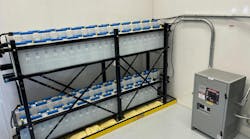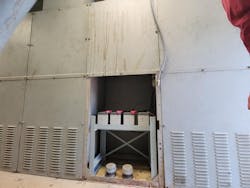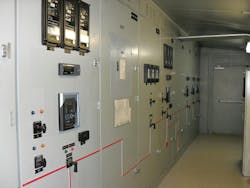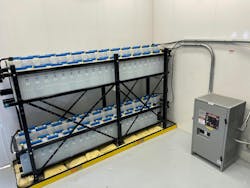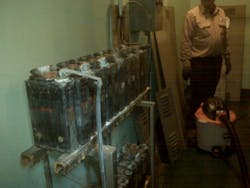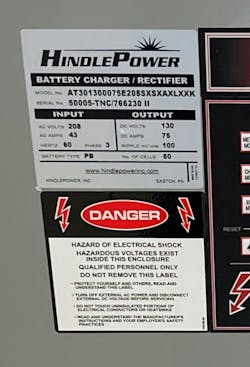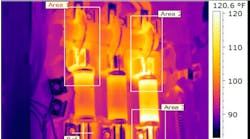Electrical power systems are often built with crucial auxiliary systems, which are often dependent on each other to ensure these power users have systems that are safe and reliable. The DC battery system might be one of the more significant of these systems.
DC batteries provide power to protective relays, breaker trip circuits, and other vital system-control systems. If these battery systems are not properly maintained and monitored, the safe operation of the entire power system will be placed in jeopardy.
When planning for DC battery system preventive maintenance, reference the ANSI/NETA Standards for Maintenance Testing Specifications for Electrical Equipment and Systems, Section 7.18.1 – 7.18.3. The specifications provide detailed recommended visual/mechanical inspections and electrical tests for batteries, chargers, and rectifiers.
Out of sight, out of mind
Deficient battery string conditions occur most commonly when a battery system is placed behind doors or covers.
One manufacturing facility suffered a catastrophic failure of its switchgear because of a loss of control power — the loss of control power to the medium-voltage switchgear created a situation where the electromechanical protective relays operated during an overcurrent condition in the system, but there was no DC control power to trip the breakers. This inability to trip the breakers allowed the fault to persist, doing more damage, until the fault was finally cleared by the upstream electric utility fuses.
The battery system had been overlooked for years because it was located in the rear of the switchgear behind a bolted cover. Photo 1 shows the battery system with the cover removed.
While this is an odd place to locate the battery system, it is not entirely rare. The equipment lineup in Photo 2 also hides a battery system.
The best solution is to place battery systems where they are visible during a standard system walk-through. In utility substations, these battery strings are typically located on the floor of the substation control room and are completely visible so that even minor issues can be observed (Photo 3).
Getting back to our failure at a manufacturing facility example, there were visible warning signs that the DC control power had failed. Unfortunately, those responsible for monitoring the power systems were not familiar enough to recognize the warning signs. You might be guilty of this too if you have ever ignored a breaker with a red (breaker closed) light that is not illuminated. This could indicate something as simple as a blown lamp, but it could also be something as critical as a bad trip coil or a complete loss of control power — as was the case in this example.
Battery neglect leads to corrosion
Photo 4 illustrates the worst case of battery corrosion. This situation clearly indicates the power system was neglected with no service or inspection for many years.
The facility lacked the trained personnel necessary to ensure the system was properly maintained. This neglected system was discovered in response to flood recovery efforts. If not for a flood, this power system’s negligence would have likely continued.
All power system safety and reliability programs start with good housekeeping. When it comes to DC battery systems, a great deal can be learned — and issues can be avoided — from routine visual inspections. These are the items you should focus on:
- General corrosion on battery posts.
- Other cracked or damaged internals such as a cracked internal seal (Photo 5).
- Acid levels not between the high and low marks (Photo 5).
- Damage to plates including positive plate growth.
- Bright lead-sulfate crystals on the negative plates indicate the battery is being undercharged.
Inspect the battery (particularly the bottom) for material that could eventually cause a short between plates.
Lack of battery monitoring
An electric utility was making a system modification that necessitated de-energizing the control power transformer. “No problem, right?” they said. “Our substation doesn’t need AC power except for lighting and air conditioning in the relay control house.” Of course, this also created a loss of AC power to the battery charger.
During a short window — from a few hours to even as much as a couple of days — this is not an issue. However, the lack of a charging current causes the battery string to be slowly depleted. In this particular case, the slow depletion of the batteries created a DC undervoltage condition that led to protective devices tripping and knocking the entire substation offline. This interrupted power to thousands of customers. Recovery efforts included having to bring in a portable generator to power the charger as well as relays to be reset and breakers closed.
Most power system designs include DC battery-voltage monitoring by the protective relays. Those same systems will also trip breakers before the DC control power becomes too low to protect the system from being in a configuration where the breakers wouldn’t be able to trip.
Modern communication technology can be utilized to provide early warning for this type of system issue. In this example, a text message to the substation supervisor would have allowed an intervention to avoid the system tripping itself offline.
Inspection and testing
- Note any indicator lights on the battery charger that represent a fault condition and/or error codes on a display. Avoid normalizing deviation and maintain an error code and fault-free system. Positive/negative DC grounds are one example of errors that can be difficult to resolve. Troubleshooting this type of error takes time and the ability to isolate portions of the system to locate and correct the ground.
- Measure the voltage of the entire battery string with the charger DC output breaker off.
- Measure the voltage of each half of the battery string. This value should be roughly half of the measurement of the entire string. Any significant variation should be investigated by measuring the voltage of each cell (which is also an option; it just takes longer).
- Measure the charger output for AC ripple. Excessive AC ripple can shorten battery life by creating a situation where the battery is repeatedly undercharged and discharged.
- One battery manufacturer recommends that a maximum ripple of 1.5% of the voltage be allowed during the bulk phase of the charging and a maximum of 0.5% voltage ripple during the float phase.
- Remember to check battery charger manufacture literature for ripple levels. The nameplate in Photo 6 lists the design ripple as 100mV rms.
- Float and equalize charger settings. Settings that are too low or too high will damage the batteries and shorten their service life.
- Check the specific gravity level of the batteries.
- Perform a load bank test.
Safety first
Remember to always use the appropriate personal protective equipment (PPE) when working on and around batteries. Ensure that eye wash stations are available and working (the water tank is full and/or water is available to the system). Use insulated tools when working on a battery system. Wrapping a wrench or screwdriver with electrical tape does not make it an insulated tool.
Electrical Testing Education articles are provided by the InterNational Electrical Testing Association (NETA), www.NETAworld.org. NETA was formed in 1972 to establish uniform testing procedures for electrical equipment and systems. Today the association accredits electrical testing companies; certifies electrical testing technicians; publishes the ANSI/NETA Standards for Acceptance Testing, Maintenance Testing, Commissioning, and the Certification of Electrical Test Technicians; and provides training through its annual conferences (PowerTest and EPIC — Electrical Power Innovations Conference) and its expansive library of educational resources.
